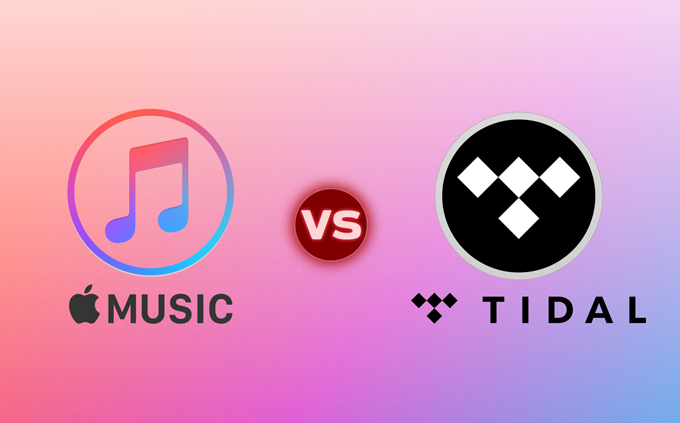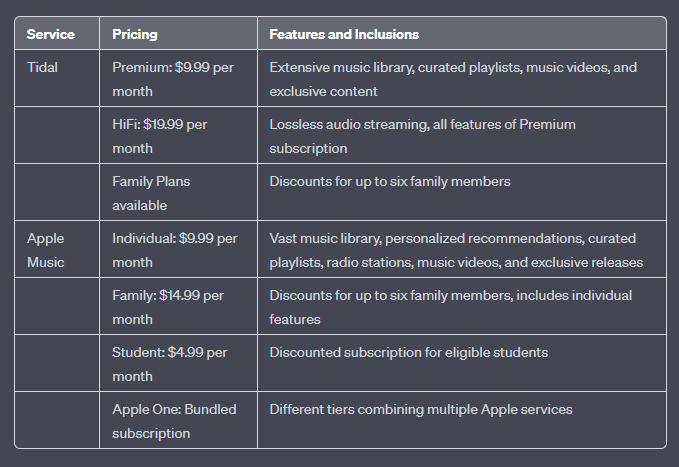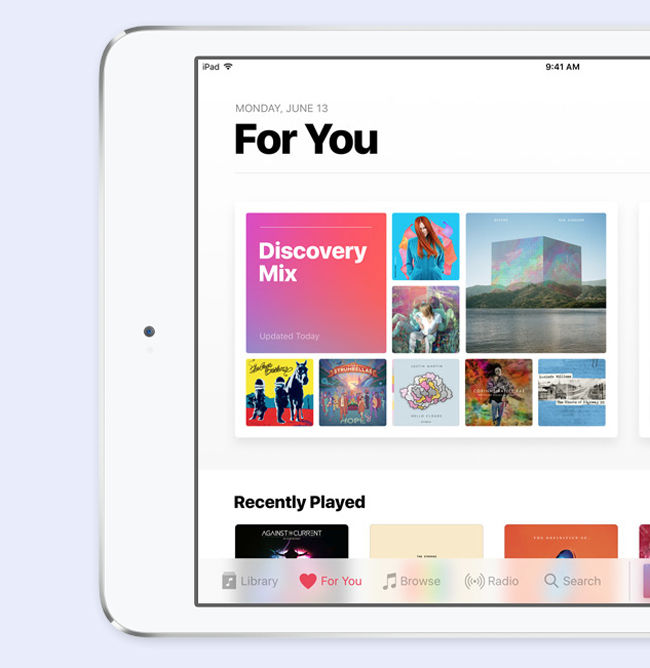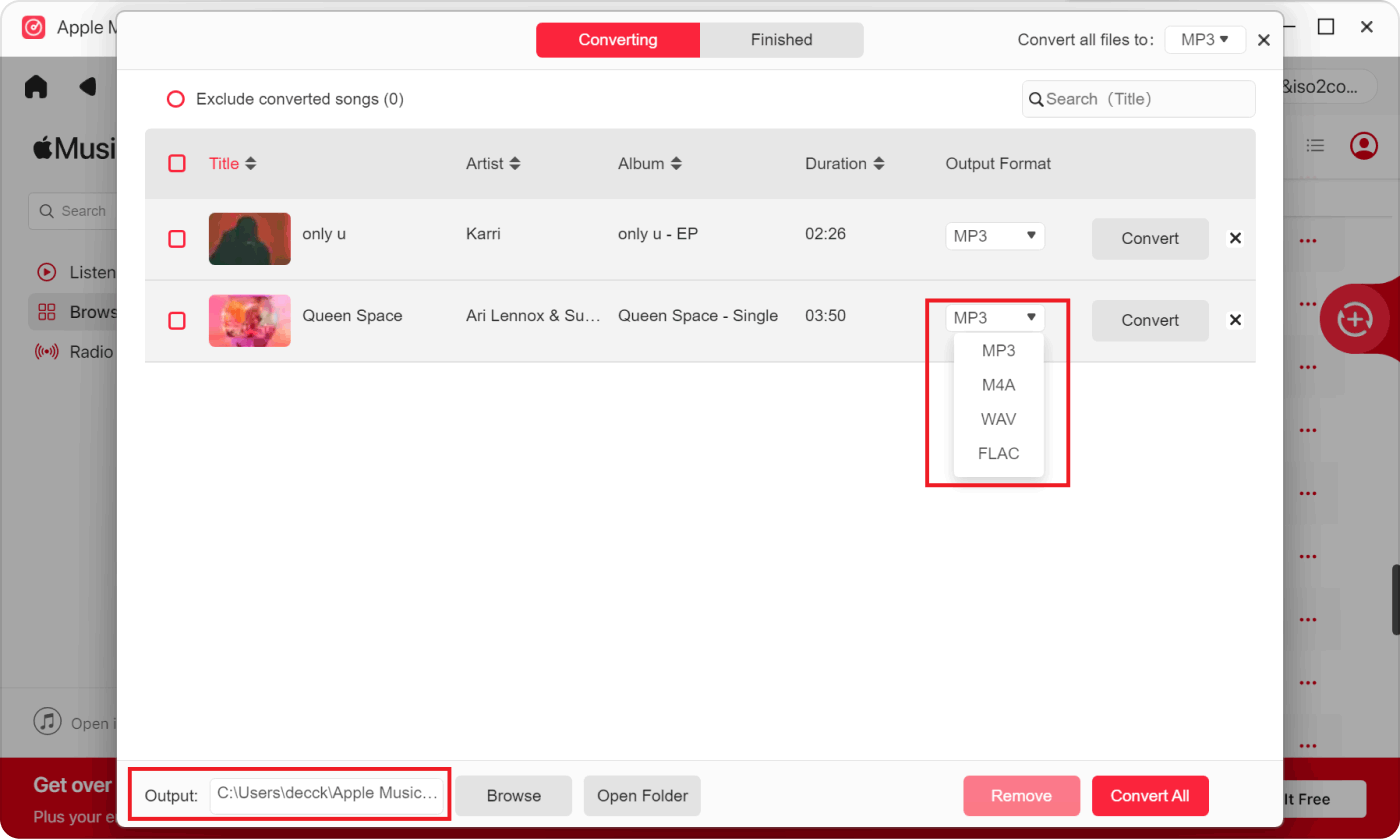In the ever-evolving world of music streaming, Tidal vs Apple Music has emerged as major players, captivating millions of music enthusiasts worldwide. Both services offer a vast library of songs, exclusive content, and unique features. But when it comes to Tidal versus Apple Music, which platform delivers the ultimate music streaming experience?
In this article, we'll delve into a comprehensive comparison, examining key aspects such as audio quality, catalog size, user interface, pricing plans, and exclusive offerings. Plus a detailed guide on how to use a third-party Apple Music Unlocker to grab your favorite songs. By the end, you'll have a clearer picture of which service reigns supreme in the battle for musical dominance: Tidal or Apple Music.
Contents Guide Part #1: Tidal Vs Apple Music: A Brief OverviewPart #2: Tidal Vs Apple Music: In-Depth ComparisonPart #3: Tidal Vs Apple Music: Which Should You Choose?Part #4: Best Way to Listen to Your Favorite Music: Grab Tracks with Apple Music ConverterConclusion
Part #1: Tidal Vs Apple Music: A Brief Overview
Before we get into the battle of Tidal vs Apple Music, let us learn some background of them. Tidal, launched in 2014, has gained prominence as a high-fidelity music streaming service. Developed by the Norwegian company Aspiro and later acquired by Jay-Z, Tidal distinguishes itself by offering lossless audio quality, providing an immersive listening experience for audiophiles.
The service boasts a substantial music catalog, including millions of songs and a vast collection of high-definition music videos. Tidal also emphasizes its commitment to supporting artists and offers exclusive content, such as behind-the-scenes footage, interviews, and live performances.
Apple Music, introduced by Apple Inc. in 2015, quickly became a dominant force in the music streaming industry. Integrated seamlessly into Apple's ecosystem, it offers a comprehensive music library with millions of tracks from various genres. Beyond its extensive catalog, Apple Music provides users with curated playlists, radio stations, and personalized recommendations through its intuitive interface.
The service also stands out with its exclusive releases and collaborations with renowned artists, making it a go-to platform for music lovers across the globe.
Both Tidal and Apple Music offer unique features and have their own strengths, setting the stage for a compelling comparison of the two services. Let's now delve deeper into their respective features, audio quality, catalog size, user interface, pricing plans, and exclusive offerings to determine which service comes out on top in this musical showdown.

Part #2: Tidal Vs Apple Music: In-Depth Comparison
Comparison on Free Tier Package
When it comes to “Tidal vs Apple Music”, it's important to note that both services offer free trial periods, but neither has a permanent free tier package. Let's explore the details of their trial periods:
Tidal provides a 30-day free trial period, allowing users to explore all the features and benefits of the service without any cost. During this trial, users have access to Tidal's extensive music catalog, high-quality audio streaming, music videos, curated playlists, and exclusive content. It's worth mentioning that Tidal offers different subscription tiers beyond the trial, including a premium HiFi option for those seeking lossless audio quality.
Apple Music offers a three-month free trial to new subscribers. This trial period allows users to access the entire Apple Music library, curated playlists, radio stations, and personalized recommendations. Additionally, users can take advantage of features like music video streaming and exclusive releases. After the trial ends, users must choose a subscription plan to continue enjoying Apple Music's offerings.
Tidal Vs Apple Music: Premium Pricing And Packages
When it comes to premium pricing and packages, Tidal and Apple Music offer different subscription options tailored to meet the needs of their users. Let's take a closer look at what each service offers:
Tidal:
- Premium: Tidal’s Premium subscription costs $9.99 per month and provides access to their extensive music library, curated playlists, music videos, and exclusive content. However, it offers standard sound quality similar to other popular streaming platforms.
- HiFi: Tidal’s HiFi subscription is priced at $19.99 per month and is designed for audiophiles who crave top-notch sound quality. With HiFi, users can enjoy lossless audio streaming, providing a more immersive and detailed listening experience. This tier also includes all the features of the Premium subscription.
- Family Plans: Tidal offers family plans for both Premium and HiFi subscriptions, allowing up to six family members to enjoy the service at discounted rates.

Apple Music:
- Individual: Apple Music’s individual subscription is priced at $9.99 per month and provides access to their vast music library, personalized recommendations, curated playlists, radio stations, music videos, and exclusive releases.
- Family: Apple Music offers a family plan at $14.99 per month, which allows up to six family members to enjoy the service together. This plan includes all the features of the individual subscription.
- Student: For eligible students, Apple Music offers a discounted subscription at $4.99 per month. Students must verify their enrollment to take advantage of this offer.
- Apple One: Apple Music is also available as part of Apple One, a subscription bundle that combines various Apple services like Apple Music, Apple TV+, Apple Arcade, and iCloud storage. Apple One offers different tiers with varying services included at discounted rates.
It's worth noting that both Tidal and Apple Music occasionally run promotional offers, so it's a good idea to keep an eye out for any discounts or deals that may be available.
Content Offerings
When it comes to “Tidal vs Apple Music”, both of them offer extensive music libraries and exclusive offerings. Let's examine their content offerings to determine which service might suit your musical preferences better:
Tidal has made a name for itself by emphasizing exclusive content and supporting artists. The platform features a vast catalog of songs from various genres, including popular hits and niche tracks. Tidal also provides exclusive releases, giving users early access to new music from top artists.
Additionally, the service offers exclusive content such as behind-the-scenes footage, interviews, and live performances, allowing users to delve deeper into their favorite artists' creative processes. Tidal's commitment to exclusive content and artist support adds a unique value proposition for music enthusiasts seeking a more immersive experience.
Apple Music boasts an extensive music library, rivaling that of Tidal. With millions of songs available, users can discover music from diverse genres and eras. Apple Music also excels in its curation efforts, providing personalized recommendations, curated playlists, and radio stations tailored to users' tastes.
Moreover, Apple Music features exclusive releases and collaborations with well-known artists, offering users the opportunity to access special content and premieres. The service's emphasis on personalized curation and exclusive offerings makes it a compelling choice for users looking for a well-rounded music streaming experience.
Determining which service has better content ultimately depends on individual preferences. If you value exclusive content, behind-the-scenes access, and artist support, Tidal may be the preferred choice. On the other hand, if you appreciate a vast music library, personalized curation, and exclusive releases, Apple Music might be more appealing.
Audio Quality
Audio quality is a crucial aspect for music enthusiasts, and both Tidal and Apple Music offer different options to cater to varying preferences. Let's compare the audio quality of Tidal and Apple Music:
Tidal stands out for its emphasis on high-quality audio. The service offers two main tiers for audio quality. Tidal's Premium subscription provides standard sound quality, comparable to other popular streaming platforms. The audio is encoded at a bitrate of 320 kbps, delivering a solid listening experience for most users.
Tidal's HiFi subscription is a standout feature for audiophiles. It offers lossless audio quality, delivering studio-quality sound with a bitrate of up to 1411 kbps. This tier provides the ultimate audio fidelity, preserving every detail and nuance of the original recording.
It's worth noting that to enjoy the HiFi audio quality, users need to have equipment that supports lossless playback, such as high-quality headphones or speakers. Without the appropriate equipment, the difference in audio quality may not be as noticeable.
Apple Music offers consistent audio quality across its platform. The audio is encoded at 256 kbps, which is generally considered to be of good quality and provides an enjoyable listening experience. While it doesn't offer a dedicated lossless audio option like Tidal's HiFi, the audio quality on Apple Music is well-regarded and sufficient for most users.
In 2021, Apple Music introduced the "Spatial Audio with Dolby Atmos" feature, which brings immersive, three-dimensional audio experiences to supported devices. This feature enhances the audio experience by providing a more encompassing and multidimensional soundstage.
When it comes to audio quality, Tidal's HiFi subscription stands out for its lossless audio option, offering an unparalleled experience for those who prioritize top-notch sound fidelity. However, Apple Music provides a solid audio quality at 256 kbps and adds value through its Spatial Audio feature, creating a more immersive listening environment.
Music Discovery
Music discovery is an essential aspect of any music streaming service, as it allows users to explore new artists, genres, and songs that align with their preferences. Let's compare the music discovery features, of Tidal VS Apple Music:
Tidal offers several features to aid music discovery:
- Curated Playlists : Tidal provides a wide range of curated playlists created by music experts and artists. These playlists cover various genres, moods, and themes, helping users discover new music based on their preferences or specific occasions.
- My Mixes : Tidal generates personalized mixes based on users’ listening habits, similar to other popular streaming services. These mixes combine familiar favorites with new recommendations, making it easier to discover songs and artists that align with users’ musical tastes.
- Tidal Rising : Tidal showcases emerging and independent artists through its Tidal Rising program. This feature highlights talented musicians who are gaining recognition, offering users the opportunity to discover and support new talent.
Apple Music excels in music discovery, providing several features to help users explore new music:
- Personalized Recommendations : Apple Music’s algorithm analyzes users’ listening habits, likes, and dislikes to offer personalized music recommendations tailored to individual tastes. The “For You” section curates playlists, albums, and suggested tracks based on users’ preferences, providing a personalized music discovery experience.
- Apple Music Radio : Apple Music offers a wide range of radio stations covering various genres, curated by expert DJs and music tastemakers. These stations introduce users to new artists and songs, providing an avenue for music exploration.
- Apple Music Editors : Apple Music employs a team of editors who curate playlists and albums, showcasing new releases, trending tracks, and hidden gems across different genres. These editorial picks serve as a valuable resource for music discovery and staying up-to-date with the latest music trends.

Both Tidal and Apple Music offer robust music discovery features, but Apple Music's personalized recommendations, radio stations, and curated editorial content provide a strong foundation for users to explore and discover new music. Tidal's curated playlists and Tidal Rising program offer unique opportunities for discovery, particularly for users interested in exploring emerging artists and exclusive content.
Unique Features
Tidal vs. Apple Music offers additional features that set them apart from each other. Let's explore the unique features of each service:
Tidal offers the following notable features that are not available in Apple Music:
- HiFi and Master Quality Audio : Tidal’s HiFi subscription provides lossless audio quality, catering to audiophiles who seek the utmost fidelity in their music listening experience. In addition, Tidal offers a “Master” quality tier that features tracks in high-resolution audio formats, delivering even greater audio detail and depth.
- Tidal X : Tidal X is a feature that provides exclusive content, including live performances, concerts, and behind-the-scenes footage. Tidal has been known for its emphasis on supporting artists and providing exclusive access to their content, making Tidal X a unique feature for fans to engage with their favorite artists.
- Artist Radio : Tidal offers an Artist Radio feature that allows users to create personalized radio stations based on their favorite artists. Users can discover related artists, genres, and tracks, enhancing their music exploration within the Tidal platform.
Apple Music also offers distinctive features that set it apart from Tidal:
- Apple Music Connect : Apple Music Connect allows artists to directly interact with their fans by sharing updates, behind-the-scenes content, and exclusive releases. It creates a social platform within Apple Music, fostering a closer connection between artists and their audience.
- Lyrics Integration : Apple Music has integrated lyrics into its platform, allowing users to view synchronized lyrics while listening to their favorite songs. This feature enhances the music experience by enabling users to sing along or delve deeper into the song’s meaning.
- Apple Music TV : Apple Music TV is a dedicated music video channel that offers a curated selection of music videos, live performances, and exclusive content. It provides users with a visual companion to their music listening experience and an avenue to discover new music videos.
Tidal Vs Apple Music: Payment Structure for Artists?
The amount that Tidal and Apple Music pay artists can vary based on several factors, including the artist's contractual agreements, streaming rates, and the number of streams their music receives. However, it's important to note that the exact payment rates and agreements between these streaming services and artists are often confidential and not publicly disclosed.
Tidal has emphasized its commitment to supporting artists and claims to pay higher royalty rates compared to some other streaming platforms. Tidal has stated that it pays artists approximately twice the industry standard rate per stream, although the specific rates and agreements may vary depending on individual contracts and negotiations.
Apple Music, like other streaming services, compensates artists based on a pro-rata model. This means that the total revenue generated from subscriptions and advertising is divided among rights holders (record labels, distributors, and artists) based on the number of streams their music receives. The exact payout per stream can vary due to various factors, such as the country where the stream originates and whether the listener is on a free trial or a paid subscription.
It's important to understand that artists’ earnings from streaming services can be influenced by various factors, including the popularity of their music, the number of streams, and the terms of their recording contracts. Additionally, artists often generate revenue through other sources, such as live performances, merchandise sales, and licensing deals.
Part #3: Tidal Vs Apple Music: Which Should You Choose?
Tidal vs Apple Music and who is the winner ultimately depends on your personal preferences and specific needs. Both services offer unique features and cater to different aspects of the music streaming experience. To help you make a decision, here are some recommendations:
Choose Tidal if:
- You prioritize high-quality audio : Tidal’s HiFi subscription offers lossless audio quality, making it ideal for audiophiles who want the best sound fidelity.
- You enjoy exclusive content and behind-the-scenes access : Tidal’s emphasis on exclusive releases, live performances, and artist interactions through Tidal X provides a unique and immersive experience.
- You prefer curated playlists and discovery of emerging artists : Tidal offers a range of expert-curated playlists and features like Tidal Rising, which highlights talented emerging artists.
Choose Apple Music if:
- You value personalized recommendations and curation : Apple Music’s algorithm-based personalized recommendations, curated playlists, and Apple Music Editors’ picks provide tailored music discovery options.
- You want integrated lyrics and a visual music experience : Apple Music’s integration of lyrics and Apple Music TV’s curated music video content enhance the overall music listening experience.
- You are part of the Apple ecosystem : If you already use Apple devices and services, such as iPhones, iPads, or HomePods, Apple Music seamlessly integrates with these devices, offering a cohesive ecosystem. This is time-saving, after all, Tidal also supports importing the iTunes library from an external hard drive. But since it's not in the "system", it takes more steps to achieve that.
Considerations for both services:
- Music Catalog: Both Tidal and Apple Music have extensive music libraries, but it’s worth checking if they have the specific artists, albums, or genres you prefer.
- User Interface: Try out the interfaces of both services to see which one you find more intuitive and enjoyable to navigate.
- Pricing: Compare the subscription pricing and packages of Tidal and Apple Music to find the one that fits your budget and offers the features you desire.
Part #4: Best Way to Listen to Your Favorite Music: Grab Tracks with Apple Music Converter
Now set aside “Tidal vs Apple Music ”, we have a special bonus tool for you. Apple Music Unlocker is a third-party application that converts and downloads Apple Music songs, playlists, and albums for offline listening.
It promises to remove the DRM (Digital Rights Management) protection from Apple Music recordings, letting customers play their Apple Music songs on iPod, Watch, and so on.
Here’s how to use the tool:
- Install iTunes on your computer and login in.
- Launch the Apple Music Unlocker application.
- Select "Open the Apple web player " from the menu.
- In the top right corner of the window, sign in using your Apple ID.
- Select and drag the selected song title or playlist title over the red add icon to select a specific song or playlist.
- To add all songs from a playlist, open it and click the red add icon.
- Select the output format for your converted files. MP3, WAV, M4A, and FLAC are the formats available.
- Click the "Change " button and go to a different folder to change the output folder location.
- Click the "Convert " button.

People Also Read GUIDE: Top Tricks to Transfer iTunes Audiobooks to iPhone Guide: How to Transfer Playlists from Spotify to Apple Music
Conclusion
Apple Music Unlocker is a software application that allows users to convert Apple Music songs to MP3, M4A, FLAC, WAV, and other popular audio formats. The software can also remove DRM protection from Apple Music songs so that they can be played on any device or player. The answer to “Tidal vs Apple Music ” really depends, but Apple Music Unlocker should always be your first choice in the market.
Written By Rosie
Last updated: 2023-05-31